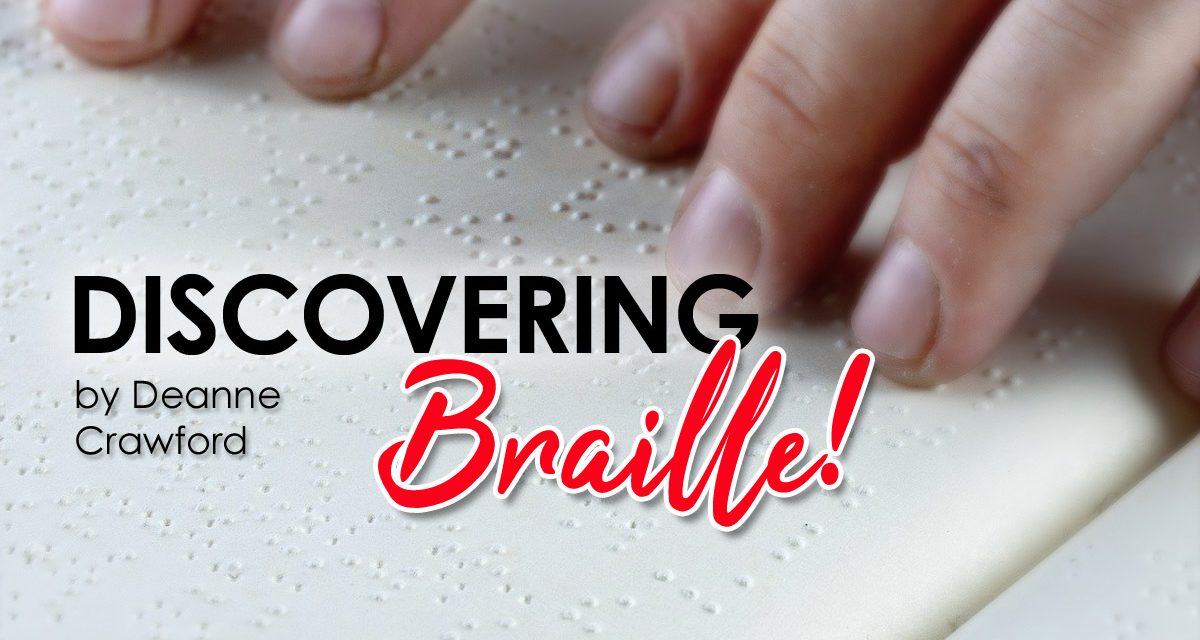Wandering through a building, you notice a strange looking sign with raised bumps. As you run your hand over them, your mind floods with questions. What are those bumps? Why are they there? Who invented them? Known as Braille code, those raised bumps are displayed in patterns to create words, allowing blind or visually impaired children and adults to read. As a family, set aside time to explore the fascinating history and methodology of this tactile reading system. You may wish to begin with the Nemour’s Foundation excellent introductions to vision and visual problems at Kid’s Health and Teen Health.
People often view Braille as a language, like French or Chinese, but this is a misnomer. Similar to the English language, Braille uses symbols to write words, mathematic and scientific equations, and music notations. Displayed as a series of rectangles (cells), the cells contain two columns of three raised dots, arranged in six dot patterns. If you are unfamiliar with Braille, imagine a domino with two columns of dots arranged within a rectangle. View Braillebug’s reference sheet. YouTube® offers Braille introductions: Sesame Street’s Big Bird Learns about Braille for younger ones and Learn Braille in One Lesson. Using Braillebug’s Name Game, learn to write your name in Braille. There are two levels or ‘grades’ of Braille. The first level is called ‘Grade 1,’ or Uncontracted Braille. Just as in the activities above, each individual letter is represented by a single cell. Once these are mastered, the second level, ‘Grade 2,’ or Contracted Braille, is shortened words. This short form code, called Contractions, is a combination of letters and other short words in a specific pattern. This combination of braille letters and symbols is commonly referred to as Braille Code.
Learning to read is a key skill. If you are blessed with sight, your parents or teachers may have used a phonics program to teach you letter sounds and their combinations to sound out words. In the United States, 75% of children learn how to read in the elementary years. Imagine that you are unable to see. You are not able to see letters and words, so they have no meaning to you. Learning Braille is necessary to communicate in writing with others. Sadly, statistics have shown that only 10% of the visually impaired learn to read or write Braille. Ask your children if they can think of reasons why this number is so low. (Research shows that this is partly due to the mainstreaming of blind students into the public school system, where significantly less time is available for learning Braille. Another factor is the belief that talking computers and audio books replace the need to learn Braille.) Is it possible that computers and audio books can replace Braille? (ask them to share opinions on this much-debated topic). While many feel technology can take the place of Braille, research shows that listening alone is not enough. Braille provides an advantage for students in learning grammar, language, math, and science.
The benefits of Braille are for both the visually impaired and sighted. Can you think of some benefits to learning Braille? (ability to communicate with visually impaired family and friends; increased confidence; future career as a translator, or my favorite–it provides children who love to read after ‘lights out’ a way to read without disturbing others). Take time to learn Braille. Begin with Braille alphabet. The popular Wikki Stix® offers a free activity guide for creating the Braille alphabet for younger children. Older children can easily create a Braille alphabet using same-size buttons, sticky gems, or other similar size raised items. Practice reading and writing Braille with the Library of Congress’ downloadable activity sheet.
This unique code for the visually impaired is named for its creator, Louis Braille, who experienced an eye injury at a young age. Although he received the best medical care for the time, sadly both eyes became infected. He was completely blind before his fifth birthday. In the 1800s, few options were available for blind children. Louis attended the local school and tried to learn by listening. When he turned 10, he received a scholarship to attend the National Institute for Blind Youth in Paris. While at the institute, he attended a lecture by an officer in Napoleon Bonaparte’s army. Napoleon was alarmed when he learned that soldiers were dying on the battlefield because they used lamps at night to read maps and orders. The light showed the enemy exactly where the French soldiers were located. He tasked Charles Barbier to create a way to protect soldiers. Wrestling with the best way to help, Barbier recalled a lecture he attended on historian Polybius. Polybius created a method for soldiers to pass messages using torches. Messages were sent using a grid pattern which is known as Polybus Squares. Inspired, Barbier created a basic grid of six horizontal rows and six vertical columns that fit the letter combinations common to the French language. His dream was to teach soldiers the grid patterns. Using a sharp pocketknife, solders cut rough markings in paper to create maps and notes to pass among the troops. This reading by touch without lights protected the location of the soldiers. Unfortunately, his system was complicated and not practical for the battlefield. While complicated for the battlefield, this code provided the perfect inspiration for Louis Braille a few short years later!
Today, Braille may seem antiquated and challenging to learn. The future of technology offers numerous advancements for the visually impaired. Browsers that read or display in Braille, to Seeing AI apps that read and scan bar codes, along with the ability to recognize people and their emotion–the future is unlimited! However, there is no substitute for reading, and no digital alternative will replace braille completely. Take time this month to learn Braille. Look for opportunities to interact with a visually impaired person. You may just receive the greatest blessing!






